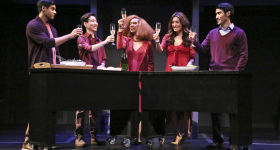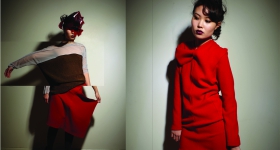Now that I'm looking at it, I can't believe that Hyphen Blog didn't cover the Asian/American/Modern/Art: Shifting Currents, 1900-1970 exhibition at the de Young last fall. Mea maxima culpa if any of you missed it because of my epic blogfail. (I did review it here, and I'll just add that, for some obvious reasons, the show moved me like I've never been moved by an exhibition before.)
Anyway, last week I attended a reading of the book that accompanies the exhibition, Asian American Art: A History, 1850-1970, by two of the book's brilliant editors, SFSU art professor Mark Johnson (who led the whole effort and curated the exhibition) and former Smithsonian curator and art critic Paul Karlstrom. (Will they marry me, in aggregate?) During the Q & A Mark mentioned a letter written by Mary Tape to the San Francisco Board of Education in 1885 on behalf of her eldest child, Mamie, who was refused entry into a white public school. Here's an excerpt:
I see that you are going to make
all sorts of excuses to keep my child out off the Public schools. Dear
sirs, Will you please to tell me! Is it a disgrace to be Born a
Chinese? Didn't God make us all!!! What right have you to bar my
children out of the school because she is a chinese Decend. They is no
other worldly reason that you could keep her out, except that. I
suppose, you all goes to churches on Sundays! Do you call that a
Christian act to compell my little children to go so far to a school
that is made in purpose for them.
Of course, she goes on to distinguish her children from the rest of the Chinese thus:
My children don't dress like the other Chinese. They look just as
phunny amongst them as the Chinese dress in Chinese look amongst you
Caucasians. Besides, if I had any wish to send them to a chinese school
I could have sent them two years ago without going to all this trouble.
... See if the Tape's is not same
as other Caucasians, except in features.
Yes sah, ABC/FOB tensions already in 1885! I'm sure Frank Chin would have trenchant things to say about this letter! Nevertheless, Mary Tape and her family made history with an early school desegregation lawsuit that was one for the books.
Tape herself was a fascinating character. Mary McGladery Tape was born in China in 1857 and orphaned or abandoned in the Shanghai area. She was brought to the US by missionaries when she was eleven, and raised to the age of sixteen at the Ladies Relief Society home, where she learned English and took on the name of her mentor, Mary McGladery. She married Joseph Tape, whose original name was Anglicized from Chew Diep. (Please note that "Chew," which became "Joe," was actually his family name, and "Diep," which became "Tape," was actually his personal name.)
Joe Tape was another immigrant who arrived in the States at the age of 17, and worked various jobs before going into business for himself around the time of their marriage. A drayman (hauler) and interpreter for the Chinese Consulate, Tape also had a business bonding Chinese crewmen, i.e. acting as a sort of bail bondsmen, providing a "bond" for Chinese ineligible to land in the US, that would enable them to get shore leave for a brief period. In this position he may, or may not, have assisted stowaways in entering the country illegally.
The Tapes appear to have been well-spoken, cultured, westernized people. As a contemporary reporter put it, their house "bore the unmistakable signs of refinement and had nothing
to make any one believe it the home of a Chinese family," and the Tapes themselves, "although
they had the features and forms of the Chinese race, everything else
about them was thoroughly American." Do have a look at the rest of the article, published around 1892, for the reporter's constant surprise at finding Chinese people who can act like Amurrkins. Sadly, it's a surprise very familiar to me.
The reporter also describes the Tape family's accomplishments: their four children were learning piano, horn, violin, and dancing, Mary herself was an award-winning photographer and painter, and she and her husband communicated across the city by telegraph. Mary made her own photographic plates and was self-taught in her artistic accomplishments. Joseph was a hunter who had a collection of stuffed birds he shot himself.
In 1884, their eldest daughter, Mamie, then eight years old, was denied admission to her local public school in San Francisco. The Tapes brought a lawsuit against the principal of the elementary school (Tape v. Hurley), which resulted in a decision that all children, regardless of race, had the right to a public school education. When the decision was upheld by the California Supreme Court, the school board responded by creating an amendment to the school code that kept "Mongolian" children out of public schools as long as there were separate schools available for them. A separate school for Chinese children was established in 1885, and San Francisco schools weren't desegregated until the 1920s, when a critical mass of Chinese children needed to go to high school. School segregation wasn't made illegal until Brown v. Board of Education in 1954.
In 1895 the Tapes moved to Berkeley and began acquiring property there, in addition to a ranch in Hayward and property in Ukiah. The family maintained those properties until the 1970s. You can read more about the family and see photographs here. Mary and Joseph Tape died within five months of each other in 1934 and 35.
The thing about the Tapes, and Mary in particular, is that their story is so common among Asian Americans today: the striving for achievement, for westernization and acceptance in the society in which they found themselves, for wealth, property and professional success. What is surprising about it is that they were the first, or among the first, to create this model of Asian American life. We now have demographic terms to describe Mary: a 1.5, a transracial adoptee (although she wasn't adopted by a family so much as by an institution.) Her ideas, desires, and level of accomplishment are things we see throughout our communities. Even her historic bid for legal justice for her children is of a piece with our conception of ourselves, and with how mainstream America conceives of us: a model minority, holding education in great esteem, and willing to hazard a great deal for the sake of our children.
I'm frustrated by the fact that there was no conception at the time of the Tapes being an American, rather than a Chinese, family. It frustrates me because I have so many questions that I would want to ask Mary about how she saw herself, her family, and her situation; but they're all questions that no one at the time would know to ask. There's a sense in the articles that the Tapes were pleased by the attention and praise that they got for being poodles who could walk on their hind legs. But Mary's letter to the school board shows another side: a frustrated attempt to name herself and her children in the absence of language that could universally define them.
We have that language now, and yet I still see that frustration in our community -- and in other American communities -- every day. It's evidence both of progress, and of the enormous amount of work we still have to do.









Comments